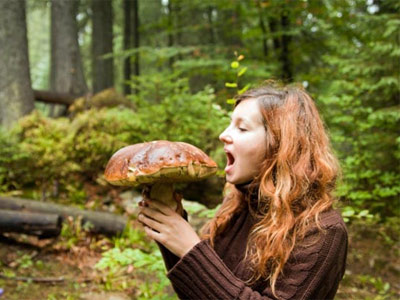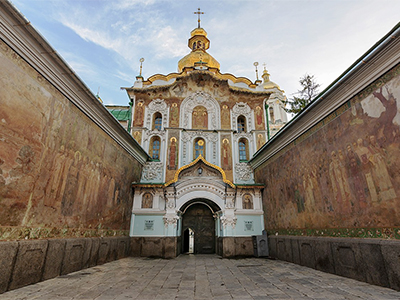 28.11.2022
Hunting Carpathian wild mushrooms
28.11.2022
Hunting Carpathian wild mushroomsIt is an exceptional pleasure to gather a basket of ripe berries or mushrooms with your own hands and to taste aromatic mushroom soup or dumplings with black bilberries. This may be especially true for dwellers of the megapolis, far removed from nature. More and more Ukrainians choose to have summer vacations not in the hot South but in the inviting green Carpathians. This is where you will find forests of fir trees, famous folklore, and from early summer to late autumn you can pick up a lot of nature’s gifts.
A Multicolored Mosaic
The first Carpathian berries to ripen are wild strawberries. As early as the end of June or the beginning of July you can find on the forest floor small plants with little red berries. In appearance and taste the wild strawberry is very much like the garden strawberry, but both its leaves and berries are considerably smaller. On the whole, all wild berries are much smaller than those cultivated. Yet, it is generally known that forest gifts are far more aromatic, tasty and, above all, more healthful than their ‘cultured cousins.’ Therefore, gathering wild forest berries will bring you not only satisfaction but also tasty remedies for many illnesses.
Both berries and leaves, and even roots of the wild strawberry can be used for medicinal purposes. The leaves are used for teas and tinctures, which have a mild diuretic effect, and are used to treat colds and vitamin deficiency, and to remove stones from the kidneys and gallbladder. Its fresh leaves are good for healing wounds. The berries are indispensable in the treatment of high blood pressure, atherosclerosis and gastric ulcer. A decoction of its roots is used to treat skin diseases and to stop bleeding.
The bilberry ripens on high mountain slopes or in shady damp places in early July. You will easily recognize the low bushes with small shiny egg-shaped leaves. The berries look like tiny dark-blue beads with a rim around a little depression on top. Inside, they are red and violet, with a lot of tiny seeds.
The bilberry is mostly known for its positive effect on eye sight. It accelerates regeneration of the retina, improves keenness of eyesight in twilight, extends the range of vision and decreases eye fatigue. Bilberry twigs are used for making an aromatic tea is good for upset stomach and for regulation of metabolism, also having an anti-inflammatory and antispasmodic effect. It is also known that bilberry leaves have some characteristics of insulin and can be used in the treatment of diabetes. Tinctures and decoctions made of the berries can be used for compresses in case of bumps or skin damage and for the treatment of throat diseases.
The white mushroom is considered to be the most valuable among the known edible mushrooms.
In August in the Carpathian Mountains, blackberries and red huckleberries become ripe (called ‘gogodza’ in the Sub-Carpathians). The blackberry looks very much like the raspberry, but its branches creep on the ground, and its berries are dark-violet (it is sometimes called black raspberry). The red huckleberry grows on bushes with evergreen oval-shaped leaves, slightly curled downwards. Dry red huckleberries are included in vitamin-rich teas; fresh berries can be stored or preserved as jam. Huckleberry leaves are brewed and used as diuretic remedies. It is also known for its antiseptic qualities.
Fresh blackberries are used as a mild sedative; they also relieve fatigue, reduce fever and are used in the treatment of kidney diseases. Pectin contained in the berries can rid the human body of radioactive substances and heavy-metal salts. The fresh berries improve brain function, intensify mental processes and improve memory and sleep. Teas brewed of dried blackberries help relieve fatigue and give body tone. A tincture of dry leaves can be used to rinse sore throats as well as treat insomnia and hypersensitivity. Crushed fresh or brewed leaves treat skin diseases. One can make jams, syrups, stewed fruit and other preserves of black raspberries to help supply the human body with vitamins and support the immune system all year round. According to American scientists, taking of blackberries is capable of suspending the development of cancer tumors.
The cranberry can be spotted in the Carpathians as well, even though it is believed to grow only in the North. This berry grows in very damp places and ripens in late autumn. Its bushes creep on the ground and branches can reach up to 80 centimeters long. Its leaves are very small, with a silvery coating beneath. Medicinal extracts, syrups and juice are made of cranberries. Mixed with honey, the juice is used as an effective remedy for coughs, and diluted with water, it helps to reduce fever and quench thirst. Cranberry juice is used in folk medicine to treat skin diseases. Berries are recommended in the treatment of oncological diseases. Persons suffering from ulcers would be advised to take them. But cranberry’s most medically acknowledged therapeutic application is for treatment of urinary-tract infections.
Mushrooms – Favorites of the Wood
Of the 200 species of mushrooms growing in the Carpathians only 60 are edible. The commonly accepted favorite is surely the white mushroom (Boletus edulis), or ‘borovyk’, that is considered to be the most valuable among the known edible mushrooms. However, it is not easy to find – one should know mushroom spawning areas. Every experienced mushroom gatherer has his or her own ones. They keep these places top secret. Yet, some highlanders will gladly guide you along hidden trails, show and tell you where and which mushrooms grow more often and how to distinguish a good mushroom.
❤️Join us on our Mushroom tour in the Carpathians! Unforgettable days combining mushrooms and lots of fun.
Mushroom season in the Carpathian mountains begins in the middle of July. The most common mushrooms of that time are the chanterelles, easily spotted thanks to their bright orange color. Chanterelles can be both very small and large; the funnel-shaped cap can reach eight centimeters, and its edges are usually thin and wavy. The cap has thick creases beneath which get smoother at the stem. The stem is smooth, narrowing downwards and can be seven centimeters tall. The flesh of chanterelles is rubbery, white or yellowish, with a pleasant taste and smell. It is by the color that the true chanterelle can be distinguished from the false one – the latter is usually pink or yellow-orange. Chanterelles typically grow in families (like many other kinds of mushrooms). They can be spotted in well-lit, moderately damp places, in quite thin grass. They are very tasty with fried meat and potatoes; they can be dried and salted for winter.
At the end of July, the second wave of mushroom season begins. Then mushrooms grow particularly fast, especially after rains. Sometimes a mushroom can grow in a couple of hours, and the majority of mushrooms need from three to six days to reach their maximum size. In the Carpathian Mountains, sometimes one can find a white mushroom weighing one kilogram, and some experts assert that white mushrooms can be as heavy as three kilos!
This mushroom is recognized by its cap of nut-brown color (in different growth periods it can have a greyish, rusty or reddish hue). Its cap shape is prominent or flat, and its skin is not peeling. The stem of the white mushroom is usually very thick, of dirty-white or greyish-brown color with a fine white veil in its upper part. Its flesh has a very pleasant mushroom smell, and when chopped, it does not change its color. It should be noted that white mushrooms are very similar to ‘hirchaks’ (Tylopilus felleus), inedible mushrooms that can be recognized by their black veil on the stem and pink spores.
White mushrooms are cooked fresh, and for wintertime they are preserved dried, salted or marinated. They are not only exceptionally delicious and fragrant but also very nutritious, and they have medicinal characteristics. They are recommended in the treatment of heart valve stenosis, tuberculosis and tumours.
The second summer season is followed by the third, or autumnal season. According to folk wisdom, its peak falls in the period of birch leaves turning yellow. Then in the Carpathian forests, one can find practically all kinds of mushrooms typical of these areas. In particular, there are russules, laminar mushrooms with caps of various colours – from brown to deep red. The cap shape of small mushrooms is usually sphere-like; later it grows flat or becomes funnel-shaped. Its stem is cylindrical, usually straight, and solid or hollow inside. Its flesh is very solid, brittle or spongy. Sometimes russules have a bitter taste, but this bitterness vanishes when they are soaked and boiled.
The most fruitful autumnal season usually lasts until the first light frosts, but if the weather stays dry and windy for several weeks, mushrooms may disappear.
Picking wild berries and mushrooms conceals a significant danger – both of them can be poisonous. Therefore, when you get ready for the logo ‘hunting quietly,’ you should learn one simple rule – pick only those kinds of berries and mushrooms you know. If you happen to have the slightest doubt concerning their edible characteristics, it is better not to touch them. You should also educate your children about this issue, if they like joining you in picking mushrooms and berries. Then you and your relatives will easily avoid danger, and your trip to the woods will be pleasant as well as healthful.
-
 27.02.2024
World of pysanka
Embark on a journey into the captivating world of Pysanka, the Ukrainian...
27.02.2024
World of pysanka
Embark on a journey into the captivating world of Pysanka, the Ukrainian...
-
 29.01.2024
Exploring the Treasures of Kyiv’s Lavra Monastery
In the heart of Kyiv lies the venerable Lavra Monastery, a testament...
29.01.2024
Exploring the Treasures of Kyiv’s Lavra Monastery
In the heart of Kyiv lies the venerable Lavra Monastery, a testament...
-
 13.01.2024
Kachanivka, Eden on Earth
Rich in history, it hosted renowned artists, notably poet Taras Shevchenko.
13.01.2024
Kachanivka, Eden on Earth
Rich in history, it hosted renowned artists, notably poet Taras Shevchenko.

